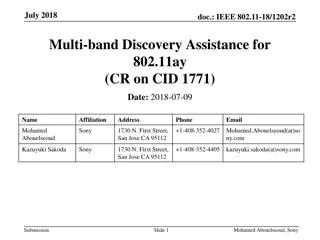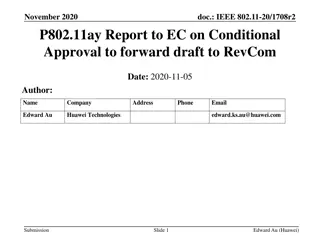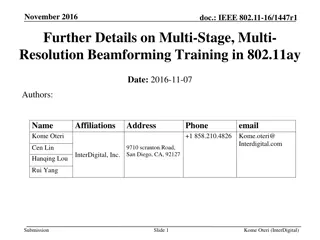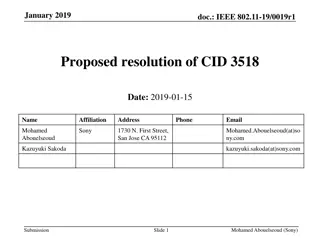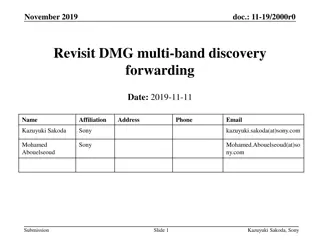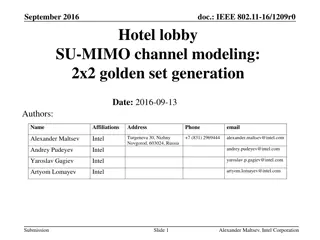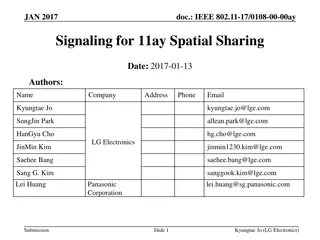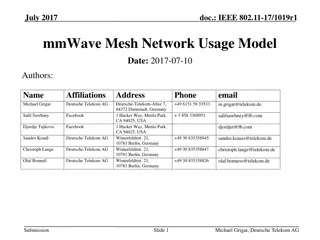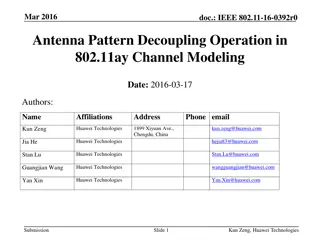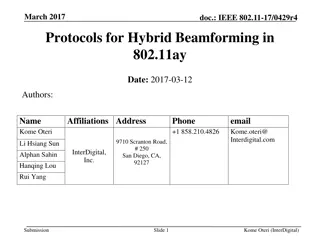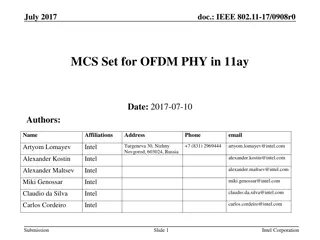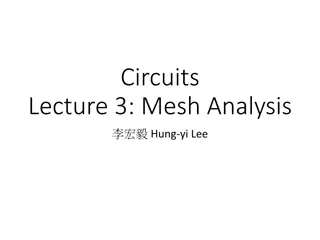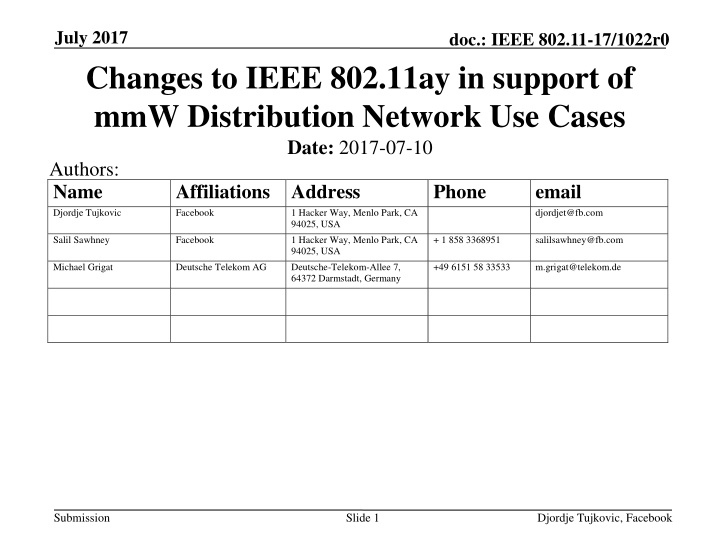
IEEE 802.11ay Changes for mmW Distribution Network Use Cases
This document discusses the proposed changes to IEEE 802.11ay for mmW distribution network use cases, including synchronization, timing drift, block-ACK, Golay code selection, and mmWave transmission indications. It also outlines the challenges in achieving the full potential of mmW distribution networks, such as co-channel interference, static nodes, and infrequent upgrades.
Download Presentation

Please find below an Image/Link to download the presentation.
The content on the website is provided AS IS for your information and personal use only. It may not be sold, licensed, or shared on other websites without obtaining consent from the author. If you encounter any issues during the download, it is possible that the publisher has removed the file from their server.
You are allowed to download the files provided on this website for personal or commercial use, subject to the condition that they are used lawfully. All files are the property of their respective owners.
The content on the website is provided AS IS for your information and personal use only. It may not be sold, licensed, or shared on other websites without obtaining consent from the author.
E N D
Presentation Transcript
July 2017 Changes to IEEE 802.11ay in support of mmW Distribution Network Use Cases Date: 2017-07-10 Authors: doc.: IEEE 802.11-17/1022r0 Name Djordje Tujkovic Affiliations Address Facebook Phone email djordjet@fb.com 1 Hacker Way, Menlo Park, CA 94025, USA 1 Hacker Way, Menlo Park, CA 94025, USA Deutsche-Telekom-Allee 7, 64372 Darmstadt, Germany Salil Sawhney Facebook + 1 858 3368951 salilsawhney@fb.com Michael Grigat Deutsche Telekom AG +49 6151 58 33533 m.grigat@telekom.de Submission Slide 1 Djordje Tujkovic, Facebook
July 2017 doc.: IEEE 802.11-17/1022r0 Abstract This presentation proposes initial set of changes to IEEE 802.11ay [1] in support of mmW Distribution Network Use Cases [2] Ability to latch state of TSF counter to external PPS (e.g. over GPIO) in distribution nodes to enable network wide timing synchronization Maximum 1usec timing drift over 100msec Implicit Block-ACK delayed to next SP allocated in opposite direction Golay code index selection per link Indication in the Beacon Transmission to indicate subsequent DTI pertains to the mmW Scheduled Access Submission Slide 2 Djordje Tujkovic, Facebook
July 2017 doc.: IEEE 802.11-17/1022r0 mmWave Distribution Network Use Cases [2] Small cell Provider Network Wi-Fi AP Fiber PoP (cabinet) Fiber PoP (to Provider Network) fiber Focus on use case specific Mesh WBH requirements mmWave AP mmWave link mmW Distribution NW LOS 60 GHz narrow beam system Own management and control per mmWave mesh access area Route control protocol supports re- routing over radio links Auto-alignment installations via adaptive beamforming Redundancy of active equipment at first pole next to fiber PoP or via connections to 2 or more fiber PoPs Radio link degradation and outage recognition w/ failure localisation WTTH Use case a) WTTH Small cell Use case c) WiFi AP / SC Use case b) WTTB WTTH Wi-Fi- AP RGW Alternative: Wireless inhouse Submission Slide 3 Djordje Tujkovic, Facebook
July 2017 Main Challenges to Achieve Full Potential for the mmW Distribution NW Use Cases doc.: IEEE 802.11-17/1022r0 Relatively large density with few hundred AP radio sectors per sqkm deployed in multi-hop multi-point topology Despite DMG PHY, the co-channel interference remains the main impediment Random nature of co-channel interference prevents any meaningful interference management and mitigation on L2 False locks mmW Distribution NW use case specifics Centralized controller for NW management Nodes are static (however, adaptive BF still needed) Upgrades for deployed topology are infrequent planned events Different set of constrains from typical nomadic use cases with handheld devices Submission Slide 4 Djordje Tujkovic, Facebook
July 2017 doc.: IEEE 802.11-17/1022r0 Co-channel Interference Typical issues with random nature of co-channel interference, exposed and hidden node problems carry over to the new mmW Distribution NW Use cases In example bellow, each lamppost installation has 4 collocated APs (aka radio sectors) Hidden node Exposed node Submission Slide 5 Djordje Tujkovic, Facebook
July 2017 doc.: IEEE 802.11-17/1022r0 Interference Between SPs Across Network Current spec enables data to be organized into CBAPs and SPs Uncoordinated SPs across APs Uncontrolled interference across NW Coordinated SPs across APs Interference still present from immediate BACK Coordinated SPs across APs with BACK delayed to next slot in opposite direction Interference can be mitigated Submission Slide 6 Djordje Tujkovic, Facebook
July 2017 Network Wide Node Synchronization and Modified delayed BACK doc.: IEEE 802.11-17/1022r0 Since nodes (APs) in mmW Mesh Network are static, random nature of intra-network interference can be minimized by semi-static coordination of transmissions (SPs) across links Provision for ability to latch the state of TSF counter to external PPS (ie, over GPIO) in each mesh node to enable network wide timing synchronization Maximum 1usec timing drift over 100msec Implicit Block-ACK delayed to next SP allocated in opposite direction For sake of this presentation, we denote this mode as the Centralized Coordination Function (CCF), as opposed to Distributed Coordination Function (DCF) Submission Slide 7 Djordje Tujkovic, Facebook
July 2017 doc.: IEEE 802.11-17/1022r0 CCF and DCF More than 6.5dB higher SIR for CCF vs DCF Extra 2dB gain in SIR at 100m link distance for P region rain assumption Submission Slide 8 Djordje Tujkovic, Facebook
July 2017 doc.: IEEE 802.11-17/1022r0 Field Data DCF CCF * max achievable (MCS12 and MCS9) Submission Slide 9 Djordje Tujkovic, Facebook
July 2017 doc.: IEEE 802.11-17/1022r0 Blocking Effect In typical wireless distribution system, co-channel interference mainly limits the operating SINR on the link In WiFi based systems, there is an additional blocking effect Packet detection is based on Preamble with STF and CE training sequences which are common to all links in the system Segregation of desired and undesired link signals is based on MAC address Receiver locks onto an early weak interference packet when T [1.2usec-? ?, 2.45us] Desired packet may be blocked from being detected Exact value of ? depends on CRS thresholds, and details of AGC and packet detection implementation Unduly limits the spectral efficiency in fixed wireless distribution system Submission Slide 10 Djordje Tujkovic, Facebook
July 2017 doc.: IEEE 802.11-17/1022r0 Golay Code Index Selection Define subset of 3-4 Golay Code Indexes (GIs) with best cross-correlation properties to be assigned to individual links upon association Default Golay sequence for onboarding mmW Distribution NW nodes can be predefined in spec, or receiver can sweep through predefined set (blind detection) Table 1: Peak suppression as function of GI pair [dB]: Third order set Example: One radio sector on each side of square, Red arrow denotes early weak interference Table 2: Peak suppression as function of GI pair [dB]: Forth order set Submission Slide 11 Djordje Tujkovic, Facebook
July 2017 doc.: IEEE 802.11-17/1022r0 Blocking Effect Field Scenario 11-9 10-5 11-8 Submission Slide 12 Djordje Tujkovic, Facebook
July 2017 doc.: IEEE 802.11-17/1022r0 Golay Code Index Selection: Field data CSR default MSC9 50% duty cycle (TDD) on both links transmitting simultaneously , max Tput per link 1.05Gbs CSR optimized Submission Djordje Tujkovic, Facebook Slide 13
July 2017 doc.: IEEE 802.11-17/1022r0 Summary of Proposal Adopt initial set of changes to Draft 1.0 of 802.11ay to support requirements for the new mmW Distribution Network use cases Enable centralized co-channel interference management and mitigation Ability to latch state of TSF counter to external PPS (e.g. over GPIO) in distribution nodes to enable network wide timing synchronization Maximum 1usec timing drift over 100msec. Recommended implementation, does not require spec change. Implicit Block-ACK delayed to next SP allocated in opposite direction The rest of MSDU to AMPDU data path unmodified Alleviate the blocking problem Golay code index selection per link Assure co-existence with other use cases in the spec Indication in the Beacon Transmission to indicate subsequent DTI pertains to the mmW Scheduled Access Submission Slide 14 Djordje Tujkovic, Facebook
July 2017 doc.: IEEE 802.11-17/1022r0 References [1] IEEE P802.11ayTM/D0.3, March 2017 [2] IEEE 802.11-17/1019r0 mmWave Mesh Network Usage Model Submission Slide 15 Djordje Tujkovic, Facebook





